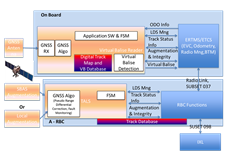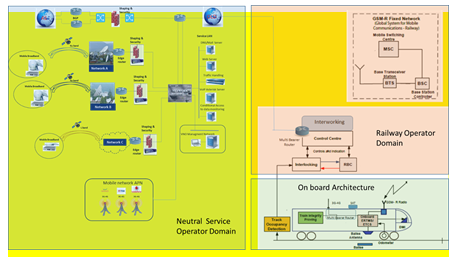SBS-RailS - Space Based Services for Railway Signalling

Programme |
Activity |
Status |
Thematic areas |
|---|---|---|---|
ARTES Integrated Applications Promotion |
Feasibility Study |
Ongoing |
The objective of the feasibility study is to determine under the technical and economical point of view the feasibility of a space aided ERTMS railway signalling system including positioning solutions using GNSS (in combination with other on board sensors) and wireless communications (satellite in combination with terrestrial communications).
SERVICE / SYSTEM CONCEPT
The SBS-RailS Study investigates how GNSS and Satcom technologies can be used within the ERTMS and its foreseen evolution.
In this context, the study is taking as input the Virtual Balise concept as it is being defined by the Next Generation Train Control (NGTC) project and the Future Railway Mobile Communications System as defined by the UIC (International Railway Union). The concept of virtual balise detection using GNSS has been defined in order to minimize impacts on the existing ETCS.
The study will additionally investigate Satcom solutions suitable for the introduction of future carrier independent telecommunication solutions as a replacement for GSM-R. The introduction of satellite technology shall minimize the modification to the existing standard ERTMS/ETCS, shall guarantee interoperability with the existing specification and shall reduce the complexity of the commissioning and of the operational scenarios.
An important part of the SBS-RailS study is the Proof-of-Concept, whose main objective is to further investigate critical issues through simulations and analysis before launching dedicated test campaigns. In particular, the following elements are included in the study:
- Characterization and modelling of multipath and interference effects on the GNSS receiver;
- High level investigation of a EGNOS dedicated integrity concept for railway, assuming minimal/no change to EGNOS infrastructure; and
- Safety analysis to determine the magnitude of risk reduction that can be achieved using EGNOS with respect to hazards originating from the system.
In the figure below, a general architecture of SBS-RailS ERTMS with GNSS is illustrated. Blue boxes represent the existing ERTMS system, Orange boxes are the new elements introduced.
The key elements are:
- TALS (Track-Area LDS Server), which represents the “Wayside and Augmentation Signalling Center” and whose main function is to provide GNSS augmentation information to the on-board.
- SBAS Augmentation and Local Augmentation represents the augmentation Sources (EGNOS in Europe, or a railway-adapted GBAS where no SBAS is available).
- The on-board receives information from the TALS using the existing safe communication channel between the trackside (RBC) and the on-board.

The Satcom solutions analysed will be assessed against the Future Railway Mobile Communication System User Requirements Specification. All the solutions taken into account will be used in a multi-bearer environment taking into account the guidelines given by EUAR for the evolution of the railways radio communication system for operation and signalling.
In the figure below, a general architecture of SBS-RailS ERTMS with Satcom is illustrated.

USERS AND THEIR NEEDS
Potential users of Space Based Services for Railway Signalling are either Infrastructure Managers and Railway Undertakings in Europe and worldwide. The study has identified the Community of European Railway and Infrastructure Companies (CER) and the ERTMS Users Group as reference users.
ERTMS solutions have been exported to several markets around the world (e.g. China, Australia and Brazil) thanks to the considerable benefits associated: increased capacity, higher speeds, higher reliability rates, lower production costs, reduced maintenance costs, open supply market, reduced contract lead time, simplified approval process, and improved safety for passengers.
The typically high investment required for the implementation of the ERTMS standard constitutes an obstacle for the deployment of such a high safety standard in Regional Lines and Local Lines.
The drivers of main cost are:
- Equipment installation and maintenance costs of the trackside;
- Train signalling on-board equipment costs; and
- Costs related to standardized communication between the trackside and on-board.
space added value
The SBS-RailS Study will target the scenario of local and regional lines in Europe. Approximately 50% of these railways are currently operated with different legacy solutions and lack in many cases the high safety standard achievable with the ERTMS.
The aim is to reduce cost (CAPEX and OPEX) of ETCS trackside by reducing the number of real balises installed along the track (reducing also exposure to theft and vandalism), and to find alternatives to terrestrial solutions for communications when terrestrial antenna deployment is not economically viable.
STATUS
The project has now reached its Mid Term Review; a general architecture has been identified. The consortium has now commenced the proof of concept activity.
See project page details:
SBS-RailS - Space Based Services for Railway SignallingCONTRACTORS
SUBCONTRACTORS
Italy
Italy
France
PROJECT MANAGERS
CONTRACTOR PROJECT MANAGER
Barbara
Brunetti
Ansaldo STS
16151
Genoa
GE
IT
ESA PROJECT MANAGER
Michele
Castriona
ESA/ESTEC
2200 AG
Noordwijk ZH
NL
Last updated date: 13 December 2023


